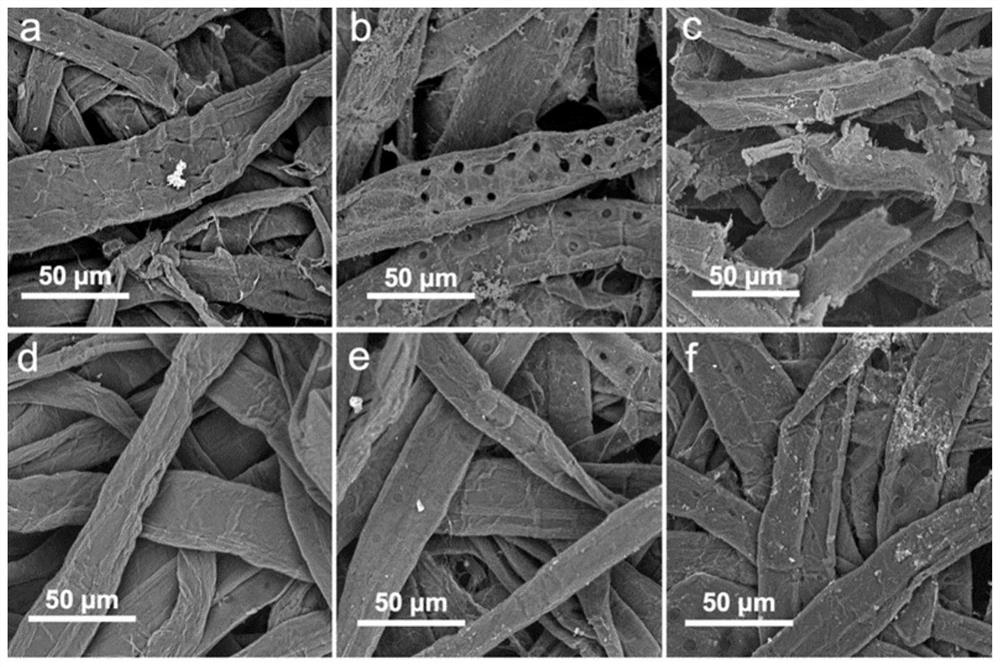Method for protecting paper cultural relics containing transition metal
A technology of paper cultural relics and transition metals, which is applied in the post-processing of waste paper, post-processing of printing, printing, etc., can solve the problems that paper cultural relics cannot be preserved effectively for a long time, solve the problem of mechanical strength and polymerization degree decline, and solve the problem of paper severe discoloration effect
- Summary
- Abstract
- Description
- Claims
- Application Information
AI Technical Summary
Problems solved by technology
Method used
Image
Examples
Embodiment 1
[0040] In this example, 2,5-hexanediol is used as an alcohol protective agent. Specifically, 80 mL of ultrapure water and 20 mmol 2,5-hexanediol are mixed to form a protective agent solution, wherein the concentration of 2,5-hexanediol is 2.95 wt%. Soak 1.6g of paper samples containing transition metal pigments in the protective agent solution, and add 1.6mmol anhydrous copper sulfate and 16mmol hydrogen peroxide at the same time to simulate the Fenton-like reaction system for the degradation of paper cultural relics containing transition metal pigments. The reaction system was placed in an oven at 90°C for 2, 6, 12, 24 and 48 hours, respectively, to fully simulate the oxidative degradation process of paper cultural relics containing transition metal pigments over a long period of time. After each reaction stage, the paper samples were taken out, washed with ultrapure water and dried naturally. It was found that the paper had no obvious color change and damage after the reacti...
Embodiment 2
[0052] In this embodiment, 2,4-pentanediol is used as an alcohol protective agent. Specifically, 80 mL of ultrapure water and 20 mmol 2,4-pentanediol are mixed to form a protective agent solution, wherein the concentration of 2,4-pentanediol is 2.60 wt%. Soak 1.6g of paper samples containing transition metal pigments in the protective agent solution, and add 1.6mmol anhydrous copper sulfate and 16mmol hydrogen peroxide at the same time to simulate the Fenton-like reaction system for the degradation of paper cultural relics containing transition metal pigments. The reaction system was placed in an oven at 90°C for 2, 6, 12, 24 and 48 hours, respectively, to fully simulate the oxidative degradation process of paper cultural relics containing transition metal pigments over a long period of time. After each reaction stage, the paper samples were taken out, washed with ultrapure water and dried naturally. It was found that the paper had no obvious color change and damage after the ...
Embodiment 3
[0058] In this embodiment, 2-butanol is used as the protective agent for alcohols. Specifically, 80 mL of ultrapure water and 20 mmol 2-butanol are mixed to form a protective agent solution, wherein the concentration of 2-butanol is 3.75 wt%. Soak 1.6g of paper samples containing transition metal pigments in the protective agent solution, and add 1.6mmol anhydrous copper sulfate and 16mmol hydrogen peroxide at the same time to simulate the Fenton-like reaction system for the degradation of paper cultural relics containing transition metal pigments. The reaction system was placed in an oven at 90°C for 2, 6, 12, 24 and 48 hours, respectively, to fully simulate the oxidative degradation process of paper cultural relics containing transition metal pigments over a long period of time. After each reaction stage, the paper samples were taken out, washed with ultrapure water and dried naturally. It was found that the paper had no obvious color change and damage after the reaction.
...
PUM
| Property | Measurement | Unit |
|---|---|---|
| degree of polymerization | aaaaa | aaaaa |
| degree of polymerization | aaaaa | aaaaa |
| degree of polymerization | aaaaa | aaaaa |
Abstract
Description
Claims
Application Information
 Login to View More
Login to View More - R&D
- Intellectual Property
- Life Sciences
- Materials
- Tech Scout
- Unparalleled Data Quality
- Higher Quality Content
- 60% Fewer Hallucinations
Browse by: Latest US Patents, China's latest patents, Technical Efficacy Thesaurus, Application Domain, Technology Topic, Popular Technical Reports.
© 2025 PatSnap. All rights reserved.Legal|Privacy policy|Modern Slavery Act Transparency Statement|Sitemap|About US| Contact US: help@patsnap.com



